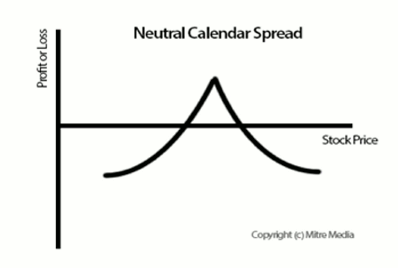The neutral calendar spread strategy is perfect for traders or investors who have a neutral outlook on a given stock or exchange traded fund, writes Justin Kuepper of ETFdb.com.
Exchange-traded funds (ETFs) provide an easy way for investors to gain access to nearly any country or asset class. In addition to providing diversified exposure in a single US-traded security, ETFs are equities themselves that may have options available to trade. These options open up the door for investors to create additional highly targeted strategies.
In this article, we’ll look at the neutral calendar spread strategy and explore how ETF investors can use it to capitalize on sideways trading.
What Is a Neutral Calendar Spread Strategy?
Suppose an investor owns a commodity ETF that he or she uses to diversify an otherwise equity-heavy portfolio. Since the ETF is being used as a hedge, the investor may not be particularly bullish on the commodity ETF’s prospects. In this case, the investor could employ a neutral calendar spread in order to generate income from this sideways trading.
The investor would simply sell one near-term at-the-money call and buy one long-term at-the-money call option to create the neutral calendar spread. The resulting position takes advantage of the short-term option’s time decay, with the maximum losses limited to the debit taken to enter into the position, making it a relatively safe and predictable strategy.
The resulting option diagram looks like this:

Who Is the Neutral Calendar Spread Strategy Right For?
The neutral calendar spread strategy is perfect for investors that have a neutral outlook on a given ETF, which can occur for a variety of different reasons. In the example above, the investor was holding the ETF as a hedge and may not be expecting it to rise or fall in the near-term. But, other examples could include any other ETF that lacks a catalyst or is trading sideways.
The strategy works best in neutral markets, where the underlying stock price remains unchanged upon expiration of the near-term call option. The ideal market for this strategy would have very little in the way of near-term fundamental catalysts and would be exhibiting sideways trading patterns when using technical analysis (e.g. within a defined price channel).
What Are the Risks/Rewards?
The neutral calendar spread strategy has a very well-defined risk to reward profile. Profit potential is limited to the premiums collected from the sale of the near-term call option minus any time decay of the long-term call option. Meanwhile, downside risks are limited to the initial debit taken to enter into the position, which goes into effect when the stock price declines.
The maximum profit and loss scenarios are:
Maximum profit occurs when the underlying stock remains unchanged upon expiration of the near-term month option.
Maximum loss occurs when the underlying stock falls and stays lower until expiration of the long-term month option.
NEXT PAGE: Details of the Strategy
|pagebreak|How to Use a Neutral Calendar Spread Strategy
Suppose that an investor owns 100 shares of the SPDR Gold Trust ETF (GLD) and believes that it will trade sideways over the coming three months. So, he or she decides to use the neutral calendar spread strategy and sell/write one near-term at-the-money JUN 140 call for $4.83 and buy one long-term at-the-money AUG 140 call for $6.05 for a net debit of $122 to enter the position.
There are three basic scenarios that could then play out:
Below 140.00. If the stock price falls below $140 in June, the investor would realize the $483 gain from writing the call option, offset by the time decay and price depreciation on the August call option that’s owned.
At 140.00. If the stock is at $140 in June, the investor would realize the $483 gain from writing the call option, offset by just the modest time decay on the owned call option.
Above 140.00. If the stock is above $140 in June, the investor would liquidate his stock position to cover the written call (or cover it at a loss), offset by the difference between time decay and appreciation on the August owned call option.
The key decisions that need to be made are often when the near-term option expires. At this point, the investor can either write another near-term call option to replace it, hold the long-term call option to profit from upside movements, or cover the position at a profit or loss. Some of this decision will depend on future volatility, with higher volatility making the long-term call option profitable and low volatility making a written short-term call option most preferable.
The Bottom Line
Investors who wish to capitalize on sideways price movements can use neutral calendar spread strategies to do so. By selling one short-term at-the-money call option and writing one long-term at-the-money call option, these investors can capitalize on the short-term option’s time decay that will lose value more rapidly than the offsetting long-term call option.
Often, neutral calendar spreads can be used without any underlying stock, but ETF investors may find it most useful to help generate an income from a hedge or other necessary position held during a sideways market. Either way, the strategy is a useful tool to have available in any trader’s repertoire.
By Justin Kuepper, Contributor, ETFdb.com





















